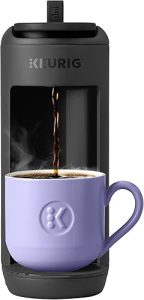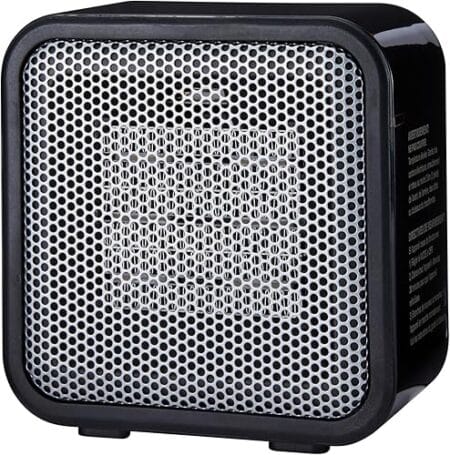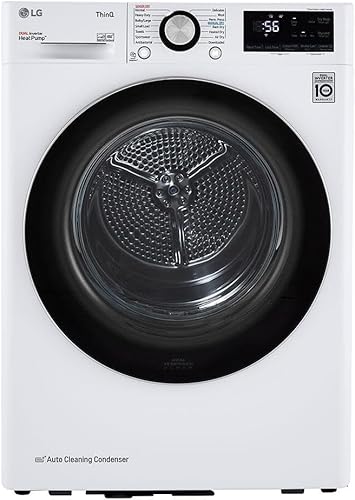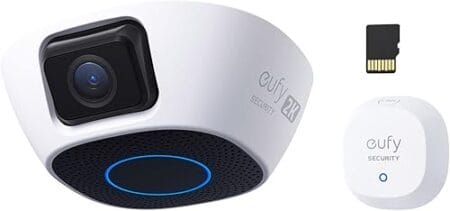If your home has too much humidity, the best dehumidifiers are necessary since they will help to avoid mold growth and minimize condensation. This is particularly true in the winter months when we are unable to leave our windows open for extended periods to let in fresh air. Dehumidifiers can also aid in eliminating odors and lowering dust and allergens in the air.
However, choosing the best dehumidifier for your requirements might be challenging because there are so many different kinds available. Fortunately, we have spent a great deal of time in humid rooms and wet basements to identify the best dehumidifier available, so you do not have to.
The Honeywell 50 Pint dehumidifier, our winning device, can be useful if your room is especially large or humid. It has a larger capacity and a hose to make draining the water easier, in addition to performing well in all of our tests. Additionally, if you have multiple rooms, it would be worthwhile to get a more compact, portable device, such as the Midea 20-pint cube dehumidifier. The best dehumidifiers for any room, requirement, and lifestyle are listed below if you want to swiftly address the humidity in your house.
1. Honeywell 50 Pint Portable Dehumidifier
Controlling humidity in vast areas, such as enormous basements, is difficult. If the space is divided, utilizing multiple humidifiers is a viable solution, but it will cost more money and use more energy. Thankfully, the 50-pint Honeywell dehumidifier is designed especially to tackle the challenging chore of dehumidifying huge areas. In fact, according to Honeywell, it can manage up to 4,000 square feet. That is quite enormous. The unit itself has a 14-pint water tank and can process up to 50 pints per day. If you do not use the provided hose to drain automatically and continually, you might have to empty that tank a lot.
The Honeywell 50 Pint Dehumidifier operates silently, effectively, and swiftly in huge areas. Large basements or even larger rooms, as well as areas with high levels of constant humidity, are excellent candidates for this type of flooring. Large spaces up to 4,000 square feet, such as basements, are perfect for the Honeywell 50-pint dehumidifier. Given that it is roughly 26 inches tall and weighs nearly 43 pounds, its size is appropriate for the job. Thankfully, it is easy to move on the wheels that come with it, and a huge handle offers a solid grip area if you need to pick it up.
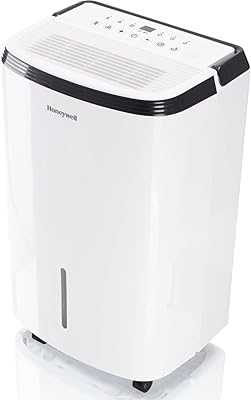
Honeywell 50 Pint Energy Star Smart Dehumidifier for Basements & Large Rooms Up to 4000 Sq. Ft. with WiFi, Alexa Voice Control, and Anti-Spill Design
It easily blends into almost any room thanks to its simple white casing. After all, it is a dehumidifier, and you want it to blend in with the interior design. However, it still has certain contemporary features that give it a hip look, such as the unit has a front-mounted mirage display that appears to glow directly through the dehumidifier’s face. Additionally, there is a digital display on top for a more readable readout while you are doing different tasks.
When you are ready to empty the detachable water tank, the splash guard helps keep water from pouring over the tank’s side. The Honeywell 50-pint dehumidifier comes with a drain tube if you plan to use it continuously.
Verdict
In huge areas and extremely humid locations, the Honeywell 50-Pint Dehumidifier operates swiftly and effectively. For its size, it is also quite quiet. Despite the tank’s modest size, you can use the accompanying drain pipe to run it continuously. Although pairing required more work than I would have liked, the software is simple to use and intuitive. This unit is short power cable is my only major gripe, but it can be fixed with an extension chord. It blends very well with almost any decor and is a fantastic unit for large rooms. If you want to dehumidify a tiny place, such a bathroom or home office, go for a smaller unit; if you have a vast basement, go for this one.
2. Midea 20-pint cube dehumidifier
This dehumidifier has a sophisticated design. Its cube-shaped form makes it appear contemporary and unobtrusive. The unit is top features a sizable fan, controls, and a little display. You may detach the main unit from the base, which acts as a water-collecting bucket, by raising it. Each component has a sizable, robust handle. To set up the Midea for use, you simply lift the main section out of the base, turn it 90 degrees, and set it back down inside the base; two indentations hold the main part up, leaving room for water to collect below. A small window in the bucket lets you see just how full it is. If you have a particularly humid environment, you can also connect a small drain hose to the bottom of the unit and have it empty out into a sink or wherever.
You may adjust the fan speed and mode settings, among other things, using the unit is a rather obvious control. For instance, you can program the dehumidifier to operate on High constantly or to run until the humidity falls to a predetermined level. Despite its name, the 20-pint model can hold up to three gallons of water, and you can also adjust the tank’s fill level. But three gallons of water weigh around twenty-five pounds, so you can set the dehumidifier to a lower fill level if you do not want to carry so much liquid. The dehumidifier will automatically turn off when the water level reaches that point.
It is helpful to have a dehumidifier, especially if you have allergies, because New Jersey summers are frequently hot and muggy. For a few weeks, I used it intermittently at home. I enjoyed how simple it was to empty: simply peel off the top section, carry the bucket outdoors, and dump it. It was perfect for watering the flowers.
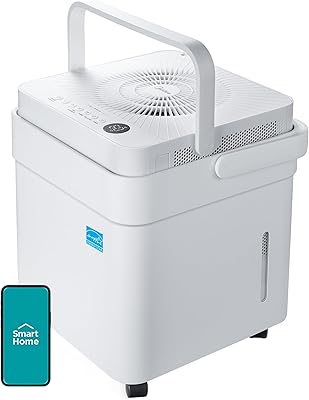
Midea Cube 20 Pint Dehumidifier for Basement and Rooms at Home for up to 1,500 Sq. Ft., Smart Control, Works with Alexa (White), Drain Hose Included, ENERG
The Midea smartphone app (Android/iOS) and Wi-Fi allow you to control the dehumidifier from your phone, view humidity levels, and receive an alert when the bucket is full. You can also adjust the dehumidifier’s settings here. The app is fairly simple to use and has a voice-activated smart assistant to control the dehumidifier (or any other Midea smart appliance), but this seems pretty redundant if you already have it connected to Alexa. I wish the company would integrate two-factor authentication into its app.
You can see humidity levels, manage the dehumidifier from your phone, and receive an alarm when the bucket is full by connecting the Midea to your Wi-Fi and using the Midea smartphone app (Android/iOS). Here, you can also adjust the dehumidifier’s settings. It is really simple to use and straightforward. The dehumidifier (or any other Midea smart appliance) may be controlled via the app’s built-in voice-activated smart assistant; however, this is quite redundant if you already have it linked to Alexa. Nevertheless, I hope the business will incorporate two-factor authentication into its software.
Verdict
I pray that none of you who are reading this are facing the possibility of thousands of dollars in property damage or a flooded basement. Although it should not be the only option in the case of a flood, the Midea dehumidifier—or any dehumidifier—performed admirably when assisting my buddy and ought to function perfectly in more normal situations. Additionally, it is quite easy to empty because of its design and the smart controls come in very helpful if you want to keep an eye on it from a distance. What more could a smart dehumidifier possibly offer?
3. HomeLabs 22 Pint Dehumidifier
At my house, the Homelabs 22-pint dehumidifier is going to get a lot of use during spring storms. My basement is approximately 900 square feet, which is within the stated range. Even though those spring storms are over, the moisture’s aftereffects are still present. After operating in my basement for a few weeks, the Homelabs 22 Pint Dehumidifier has performed admirably in removing moisture from the area. Although this little device has many drawbacks, most notably a small tank that you will need to empty often, it is generally quiet, appealing to the eye, and portable. As demonstrated in this review of the Homelabs 22 Pint Dehumidifier, it is perfect for compact areas like a bathroom or home office.
Up to 22 pints of water can be removed daily by the 22-pint dehumidifier. According to Homelabs, this unit is perfect for spaces up to 1,500 square feet, and the tank has a 0.8-gallon capacity. The unit itself has a modern, minimalist design that would look good in almost any space. The control panel, which has a small screen and simple push buttons, is integrated into the top of the device.
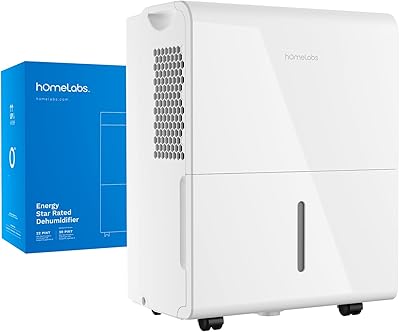
HomeLabs 1,500 Sq. Ft. WiFi-Enabled Dehumidifier, Small to Medium Size Rooms – Home, Bedroom, Bathroom – Powerful Moisture Removal – 22 Pint
The 22-pint dehumidifier is easy to move about because of its built-in handles and wheels. When not in use, the power cord can be stored on the unit is back. There are two main ways the unit functions. When the tank is full, the unit automatically turns off; if you use the household outlet for continuous draining, it will run continually. Using the app or the built-in buttons, you may manually switch the device on and off as well. The app allows you to program the unit to switch off when a room’s humidity level is reached.
I initially installed the 22-pint dehumidifier in my roughly 100-square-foot basement bathroom. This was the ideal chance to fill the air with humidity and gauge how well the 22-pint dehumidifier could extract that moisture quickly. I took a hot shower to raise the humidity level in the room to 79% before using it for the first time. Next, I adjusted the dehumidifier’s setting to 35% humidity. The humidity level dropped back to 42% after around 40 minutes. In roughly an hour, it hit the 35% mark. During operation, the machine consumed roughly 235 watts and.20 kWh.
During this initial run, the device also released a sizable amount of hot air. The air that blew out of the vents in later uses was either warm or chilly. Despite operating for nine hours, the dehumidifier failed to attain its 35% humidity objective during its second use in the bathroom. However, it appeared to hover at 37%, which was extremely close.
Following the bathroom test, I relocated the unit to the laundry room, where our sump pump is located just below the concrete pad. Throughout the spring, we receive a lot of moisture here. At around 100 square feet, it is a tiny room that connects to the larger subterranean area.
Verdict
The Homelabs 22 Pint Dehumidifier does a commendable job of controlling humidity levels in small-to-medium-sized settings, but I would not rely on it to be my only moisture management tool during Colorado’s spring storms. It looks well in any space thanks to its elegant appearance, and the simple and intuitive interface makes me use the dehumidifier more frequently than I otherwise would. Although it is rather quiet, unless you are accustomed to white noise, you might find it a little too loud in a bedroom. You will need to keep an eye on the little tank to make sure it is emptying more often if you are not utilizing the drain hose.
The Homelabs 22 Pint Dehumidifier worked well as a set-it-and-forget-it solution in little spaces, controlling humidity levels with little to no hassle. It is not always very accurate to set the unit to shut off at a certain humidity level, but it is the only issue with an otherwise excellent device. It operates well in less time and is more accurate in tiny areas. It works well in areas that are 500 square feet or smaller.
4. Honeywell TP50AWKN
The Honeywell TP50WKN dehumidifier is a stylish device that is affordable and of a decent size. There is hardly much better than Honeywell in terms of reputation and brand awareness. Dehumidifiers are becoming more and more common among homeowners and apartment renters. By pulling in moisture from the outside and chilling it, they eliminate surplus moisture from the air, which then condenses into water. The water is collected in a reservoir at the bottom of the best dehumidifiers. Because a dehumidifier eliminates extra moisture, which can make your living area feel hotter, it may improve your comfort level even though it will not dramatically cool your home.
Before spending the money, it is crucial to understand the Honeywell TP50WKN’s characteristics and performance if you have previously posed and answered the question, “How big of a dehumidifier do I need?” Dehumidifiers are not particularly inexpensive appliances, and they are frequently cumbersome to unpack and assemble. We have tested the Honeywell TP50WKN ourselves to determine its usability, performance, and usefulness, saving you the effort of maybe purchasing something you will not like. Continue reading to learn how we located it.
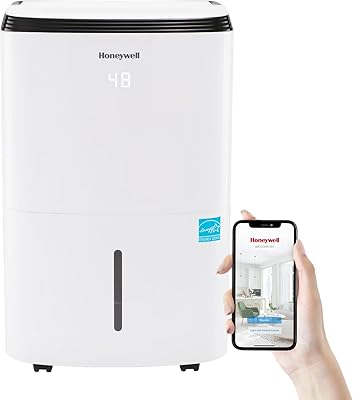
Honeywell 4000 Sq. Ft. Energy Star Smart Dehumidifier for Home Basements & Large Rooms, with WiFi, Alexa Voice Control and Anti-Spill Design – 50 Pint
The Honeywell TP50WKN was installed in a medium-sized living room on a very hot day, and when it was turned on, the LED display indicated that the humidity was 89%—and it felt that way. After an hour of continuous operation, the humidity had dropped to 42%, and the room had changed significantly; after two hours, the humidity had not decreased anymore, and the tank was about half full. The tank was filled rather quickly, but because dehumidifiers release some heat in the process, the already hot room felt a little warmer, even though the drier air was a little easier to handle than the extreme humidity.
When you put the Honeywell TP50KWN in sleep mode, the top display lights will turn off after a minute. The timer is simple to configure and has a 24-hour setting option. The sound output of the two fan speeds is not all that different from one another.
The Honeywell TP50WKN emits about 55 dB of sound from a distance of about 10 feet, which is equivalent to a conversation in a home. Except for a brief spike to 74 dB when it was first turned on, it never became louder than 61 dB while you were standing directly next to it. Overall, this dehumidifier is incredibly quiet, so you will not need to turn the TV or talk louder while it operates.
Verdict
For those who are prepared to pay a little extra for quality and brand recognition, the Honeywell TP50WKN is an excellent 50-pint dehumidifier. Spending the extra money will be worthwhile if energy efficiency is a concern for you, as will the additional features that make it stand out among other dehumidifiers. Small to medium-sized spaces up to 3000 square feet are ideal for this device, and those who simply wish to dehumidify without needing an engineering degree will love how easy it is to maintain.
5. Frigidaire FGAC5044W1
Given that dehumidifiers frequently operate in obscure areas of a house, like a basement or storage room, having the ability to monitor and operate one from a distance is advantageous. The Frigidaire Gallery FGAC5045W1 has Wi-Fi connectivity, so you can monitor and control it using the Frigidaire app on iOS and Android. You can also sync it with Google Assistant and Amazon Alexa to operate it with voice commands.
Setting up the app is simple. We were able to cycle the dehumidifier through its settings with a touch of the screen, and we discovered that its alarms were accurate. The FGAC5045W1’s 2.1-gallon bucket needs to be dumped more frequently than the Midea Cube’s, but it only weighs around 20 pounds when full and slides out without the need to hoist a bulky compressor unit. The FGAC5045W1 has the same Energy Star Most Efficient rating as the Cube.
Frigidaire’s excellent software makes this dehumidifier worth considering if you need remote monitoring and control, even if owner reviews show that Frigidaire dehumidifiers have more mechanical failure complaints than the Midea Cube. Frigidaire’s excellent software makes this dehumidifier worth considering if you need remote monitoring and control, even if owner reviews show that Frigidaire dehumidifiers have more mechanical failure complaints than the Midea Cube.
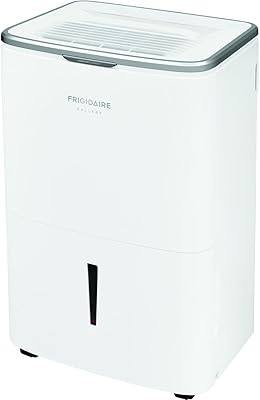
Frigidaire 50-Pint Smart Dehumidifier for Basement, Garage, Attic, 115V, Energy Star Moisture Absorber with Timer, Wi-Fi, App Control and Amazon Alexa
Although a Wi-Fi-enabled dehumidifier is not necessary, if you are a fan of smart home appliances, the Frigidaire FGAC5044W1 50-pint might be just what you need. In addition to being able to remotely adjust the fan speed, target humidity, and power, you will receive push notifications when the water bucket is full. The Frigidaire FGAC5044W1 may also be controlled by speech via Google Assistant and Amazon Alexa.
If you are monitoring a dehumidifier in a rental home or are out of town, all of these clever features can be helpful. Many online buyers of the device, however, complained about difficulties installing the app, which primarily receives bad reviews on Google Play and the App Store. Hopefully, Frigidaire will resolve that.
Verdict
Hundreds of Amazon, Wayfair, and Walmart customers gave the Frigidaire FGAC5044W1 high ratings (4.4 out of 5 stars on average), even though many of them disliked the device’s mobile app. According to Amazon, users enjoyed the dehumidifier’s functionality, usability, and humidity. They also say that the wheels perform well on cement floors and that they perform a fantastic job of removing humidity from the air. Regarding noise, value, and capacity, there are differing views.
6. Amazon Basics 35 Pint Dehumidifier
In terms of size and functionality, the Amazon Basics 35-Pint Dehumidifier is a large device. However, it performs admirably if you are looking for one of the best dehumidifiers. This 35-pint dehumidifier works effectively in extremely damp areas up to 2,500 square feet and can swiftly remove a lot of moisture. It is also a very basic, uncomplicated item. The machine has a few buttons on top, making it simple to use and understand, and there is no app to control it remotely. It is perfect for large, humid areas that need to be dried off fast, and it is reasonably priced considering its capabilities.
But for areas smaller than 600 square feet, it is excessive. Additionally, the device emits a lot of heat while operating, which can significantly affect the comfort of smaller spaces. In addition, it is the noisiest unit I have ever tested. A big, simple device is the Amazon Basics 35-Pint Dehumidifier. Because of its large, white appearance, it may be incorporated into the style of almost every room in the house.
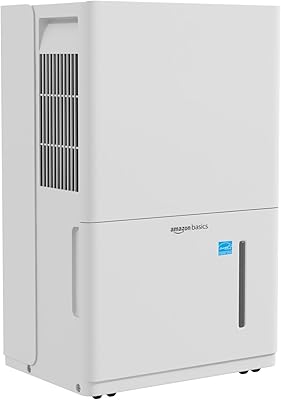
Amazon Basics Dehumidifier, 35-Pint, Energy Star Certified, for Basement, Bathroom, and Other Rooms Up to 2500 SFT, With timer, auto-defrost
This unit works best in larger spaces with lots of moisture because of its size. Keep in mind that it will occupy a lot of space in tiny spaces and is generally unnecessary in any area less than 600 square feet. You can turn the device on and make all the necessary changes using the buttons on the top. The on/off time can be adjusted from 30 minutes to 24 hours using the Timer button.
A timer indicator, a full bucket indicator, and a defrost indicator are all included on the control panel. Additionally, there is a continuity mode button that allows you to use a drain hose to run the unit constantly; however, the drain hose is not included with the device. In my about 100-square-foot basement bathroom, I tested the Amazon Basics Dehumidifier. Both my Alexa air quality meter and the Amazon device itself registered 90% humidity in the room on my first use.
The dampness in this tiny space was quickly eliminated by the huge Amazon Basics unit. It quickly reduced the humidity to 41% in just forty-five minutes. Considering how big the unit is in terms the space, it is also not shocking.
Verdict
The Amazon Basics 35-Pint Dehumidifier is more than capable of handling the heavy moisture removal needed in a large, damp basement or other area. Although it controls humidity rapidly and well, it is excessive for any place smaller than 600 ft. In addition, it emits a lot of heat and is noisy. Therefore, this might not be the ideal humidifier for you if you want to use it while the family is watching TV or while you are working from home. If noise from the unit is not an issue and you have a vast area that is prone to excessive humidity, give this equipment some thought. Steer clear of it in cramped areas or rooms where the unit may compromise comfort levels.


